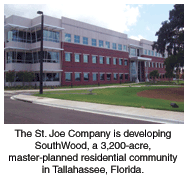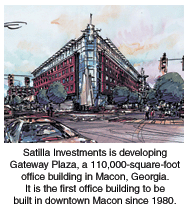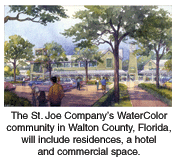A Tale of Second- and Third-Tier Cities
Executives discuss their experiences in middle markets.
Dawn Pick Benson
Being a middle market broker or developer isn’t easy.
While the largest deals often occur in major cities due to the appeal of
a prestigious address, smaller markets are sometimes overlooked. Yet, during
a time of economic downturn, many of these smaller markets seem to be faring
well compared to their big brothers and sisters — and the major players
in these smaller markets are not afraid to boast of their selling points.
Southeast Real Estate Business recently spoke with some members
of the brokerage and development community to discover their views of
smaller markets. They include Bob Copty, president of Copty & Company
in Roanoke, Virginia; Erin Ennis, managing director — North Florida
with Advantis Real Estate Services in Tallahassee, Florida; and Clay Murphey,
partner with Satilla Investments in Macon, Georgia.
SREB: What are the basic differences between working as a broker
in a smaller market versus a larger market?
Copty: I think that our experiences are similar to those in larger
markets. We tend to deal in smaller spaces and buildings compared with
larger markets, but I think the activity and process is similar.
 Ennis:
One of the most interesting aspects of being a broker in a second- or
third-tier community is that you need to have a broader base of skills.
In a major metropolitan area, most brokers are specialized. In smaller
markets like Tallahassee and Panama City, Florida, a good broker has to
be able to do an investment sale one day, write a lease the next, and
sell an industrial parcel the week after that. Ennis:
One of the most interesting aspects of being a broker in a second- or
third-tier community is that you need to have a broader base of skills.
In a major metropolitan area, most brokers are specialized. In smaller
markets like Tallahassee and Panama City, Florida, a good broker has to
be able to do an investment sale one day, write a lease the next, and
sell an industrial parcel the week after that.
A broker in a smaller market also has to complete many more transactions
to match the income level of peers in major cities because they are generally
doing leases that are 5,000 to 20,000 square feet as opposed to 40,000
to 200,000 square feet.
SREB: What does a second- or third-tier city have to offer that
a first-tier city doesn’t?
Ennis: In general, the smaller markets have been insulated somewhat
from economic shocks in the last year. I think the smaller markets are
a little more insulated in the sense that the lows are not as low —
but neither are the highs as high when markets are booming.
For Tallahassee and Panama City, much of the recruitment centers around
lifestyle. For businesses relocating to North Florida, the driving force
is the quality of life. Panama City offers easy access to the Gulf of
Mexico and a relaxed quality of life. Tallahassee is near the coast and
has universities that are very attractive. It also offers a vibrant, well-educated
and young community. These areas also don’t have traffic congestion
like major markets.
Copty: The quality of life that a smaller community offers is
a great advantage. We feel that the future is extremely bright for communities
like Roanoke. We have a magnificent quality of life, and a company can
be very efficient here. The commute time from residential areas to the
center of the city or to the vast array of cultural opportunities is just
10 to 15 minutes. Several colleges and universities are also nearby. We’ve
been ranked consistently among the best places in America to live and
retire, and it certainly is one of the best places in America to do business.
 Murphey:
I think Macon offers a slower pace of living with a unique small-town
perspective. We have a central location on the interstate system at Interstate
75 and at Interstate 16. We’re 2 hours from both the beach and the
mountains, and I think our proximity to Atlanta is also a benefit. We
are close enough to travel to Atlanta for an evening and still come home
the same day. Murphey:
I think Macon offers a slower pace of living with a unique small-town
perspective. We have a central location on the interstate system at Interstate
75 and at Interstate 16. We’re 2 hours from both the beach and the
mountains, and I think our proximity to Atlanta is also a benefit. We
are close enough to travel to Atlanta for an evening and still come home
the same day.
The cost of living is also much lower in Macon, so it doesn’t cost
as much to do business here. We’ve got a good base of employees and
some great colleges and universities here as well.
SREB: What are some of the challenges that a broker or developer
might face in a smaller market that they would not contend with in a larger
market?
Ennis: A challenge for us is educating people about the benefits
of a small city. There are also air transportation issues in that the
 routes
are limited and it’s more expensive to fly out of smaller airports. routes
are limited and it’s more expensive to fly out of smaller airports.
Copty: I think the frustration for our market has been that we
have lost tenants to larger communities. There has been some, but very
limited, relocation of companies from more dynamic markets to ours at
a cost savings. A lot of companies perceive that it is hard to attract
top talent to small communities, so they feel it’s important to have
their headquarters in a large city and at a prestigious address.
We used to have rather large banks in our community that were either
committed to the Roanoke Valley or housed here. But with all of the banks
and financial institutions that have merged, it is more complicated to
find capital. In a lot of cases, we are working with decision makers and
lenders that are no longer in the community. And it’s just another
step and another frustration to go through. I think continuing to have
the funding to grow projects is certainly one of the challenges of a smaller
market.
Murphey: Even though you can reach Atlanta’s airport from
Macon in about the same time as someone from north Atlanta, people want
that quality of life that they think a city like Atlanta brings. Large
companies don’t look to locate or relocate in our community.
Being in a small market and in tight financial times, lenders want to
know who your credit tenants are. In a small market, you don’t have
Fortune 500 companies, so you have to go to a lender and first educate
them about your tenants.
New
Developments in Second- and Third-Tier Cities
Roanoke:
Riverside Centre for Research and Technology in Roanoke,
Virginia, is a three-phase development on South Jefferson
Street that will include 1 million square feet at build-out.
It is being developed by the City of Roanoke Housing Authority,
and its first building, the 50,000-square-foot Carilion
BioMedical Institute, is currently underway.
Macon:
 Gateway
Plaza is a 110,000-square-foot, six-story, Class A office building
currently underway in the 300 block of Mulberry Street in downtown
Macon, Georgia. The developer is Satilla Investments, and the delivery
date is planned for spring 2004. Gateway Plaza is the first office
building to be built downtown since 1980. According to Clay Murphey
and Jeff Jones, partners at Satilla Investments, the development
has been well received and is already 65 percent pre-leased. Gateway
Plaza is a 110,000-square-foot, six-story, Class A office building
currently underway in the 300 block of Mulberry Street in downtown
Macon, Georgia. The developer is Satilla Investments, and the delivery
date is planned for spring 2004. Gateway Plaza is the first office
building to be built downtown since 1980. According to Clay Murphey
and Jeff Jones, partners at Satilla Investments, the development
has been well received and is already 65 percent pre-leased.
A mixed-use riverfront development is also being planned for downtown
Macon. It will be a 5-year, $70 million project, and proposals from
developers are currently being accepted.
 Northwest
Florida: Northwest
Florida:
The St. Joe Company is currently developing many projects. Key developments
include two projects in Northwest Florida, WaterColor and WaterSound.
WaterColor Crossings is a 499-acre coastal resort and residential
community in south Walton County. At build-out, the community will
include 1,140 residences, a 60-room inn and 100,000 square feet
of commercial space. Nearly half of the site will be devoted to
open space and preservation areas. WaterSound is a master-planned
resort and residential community under development in Northwest
Florida. It will include 499 residences, a village center, community
gathering spaces and landscaped parks.
|
©2003 France Publications, Inc. Duplication
or reproduction of this article not permitted without authorization
from France Publications, Inc. For information on reprints of
this article contact Barbara
Sherer at (630) 554-6054.
|
